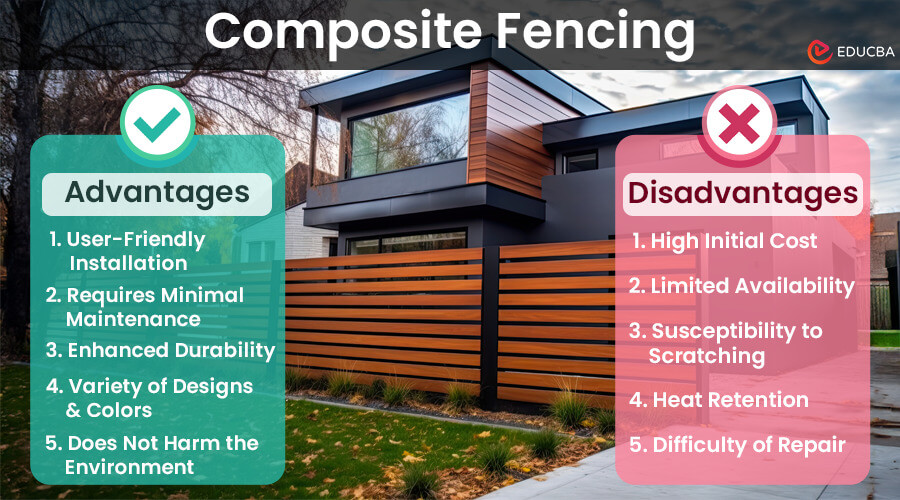
Introduction to Advantages and Disadvantages of Composite Fencing
Composite fencing has become increasingly popular as an alternative to traditional wood or metal fences. The fencing material is a mix of wood fibers (often recycled) and plastic materials (typically polyethylene or polypropylene). Here is a guide on the advantages and disadvantages of composite fencing.
Advantages and Disadvantages of Composite Fencing
A) Advantages of Composite Fencing
Composite fencing offers several advantages over traditional fencing materials like wood or vinyl. Here are some of the key advantages:
#1. User-Friendly Installation
Composite fencing can be more efficient and cost-effective than traditional wood fences, particularly for those who enjoy DIY projects, as it can save time and labor. It is because many composite fencing systems are easy to install. They have interlocking panels or pre-drilled holes that streamline the process.
#2. Requires Minimal Maintenance
Unlike wood fencing, composite fencing does not require painting, staining, or sealing to maintain its appearance and structural integrity. Simply occasional cleaning with soap and water is usually sufficient to keep it looking great for years.
#3. Enhanced Durability
Composite fencing is strong and durable. It does not rot, get bugs, bend, or decay easily. It can handle tough weather without damage and last for a long time.
#4. Variety of Designs and Colors
Composite fencing comes in many different looks and colors, so homeowners can pick one that matches their property’s look. Whether one prefers a timeless wood-like appearance or a contemporary design, a composite fence style exists to cater to individual preferences.
#5. Does Not Harm the Environment
Choosing composite fencing is a sustainable choice. It is often crafted from recycled materials, such as reclaimed wood fibers and recycled plastics, which helps reduce waste. Its long lifespan also means fewer replacements, reducing environmental impact.
#6. Resistant to Fading
Composite fencing resists fading and maintains its color and appearance over time. UV inhibitors are typically added during manufacturing to protect against sun damage. It ensures your fence retains its vibrance for years.
#7. Strength and Stability
Composite fencing panels are sturdy and stable and offer improved security and privacy for your property. Compared to some other fencing materials, they are less likely to bend, sag, or break, which makes them ideal for areas with high winds or frequent storms.
B) Disadvantages of Composite Fencing
While composite fencing has numerous advantages, there are also some disadvantages to consider:
#1. High Initial Cost
Composite fencing typically costs more upfront than traditional materials like wood. While the long-term savings from reduced maintenance and replacement costs can offset this, the initial investment may deter some homeowners.
#2. Limited Availability
Depending on your location, composite fencing may not be as readily available as other materials. This could result in longer lead times for ordering and installation, especially if you are looking for specific styles or colors.
#3. Susceptibility to Scratching
Composite fencing can be susceptible to scratching, particularly from sharp objects or heavy impacts. Although minor scratches might not catch the eye, deeper ones can significantly diminish the fence’s visual appeal. However, some composite materials come with protective coatings to minimize scratching.
#4. Heat Retention
In sunny climates, composite fencing may retain more heat than materials like wood, which makes it uncomfortable to touch during hot weather. While this is generally not a significant issue, it is something to consider if you live in an area with extreme temperatures.
#5. Difficult of Repair
Repairing composite fencing can be more challenging than repairing wood fencing because replacing individual boards or sections is not as easy. Matching colors and textures can be difficult, and repairs may require replacing entire panels.
Final Thoughts
Composite fencing has advantages, like being durable and environmentally friendly, but there are also disadvantages, such as the higher initial cost and limited availability.
Whether it is the right choice depends on what matters most to you—like your willingness to spend and the style you prefer. Despite its challenges, many prefer composite fencing because it is durable and attractive. It is becoming more popular for those who want a long-lasting and visually appealing fence.
Recommended Articles
We hope our article on the advantages and disadvantages of composite fencing was helpful. Consider visiting the following recommendations for similar content-based articles.
